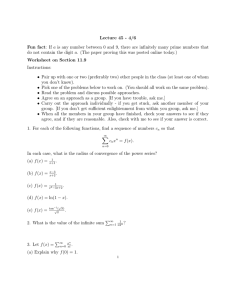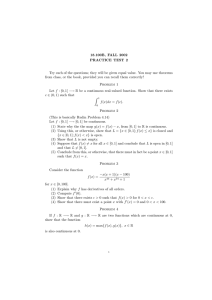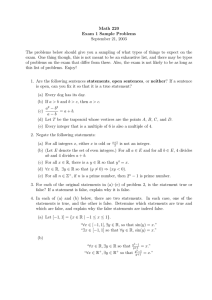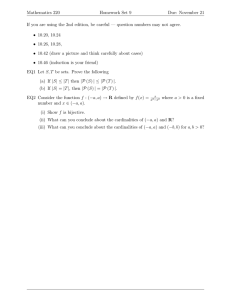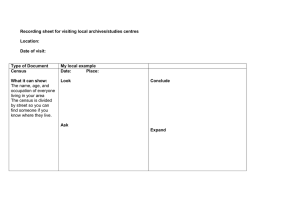The group structure of (ℤ/nℤ)* Ali Nesin I. Ring Decomposition. Ia
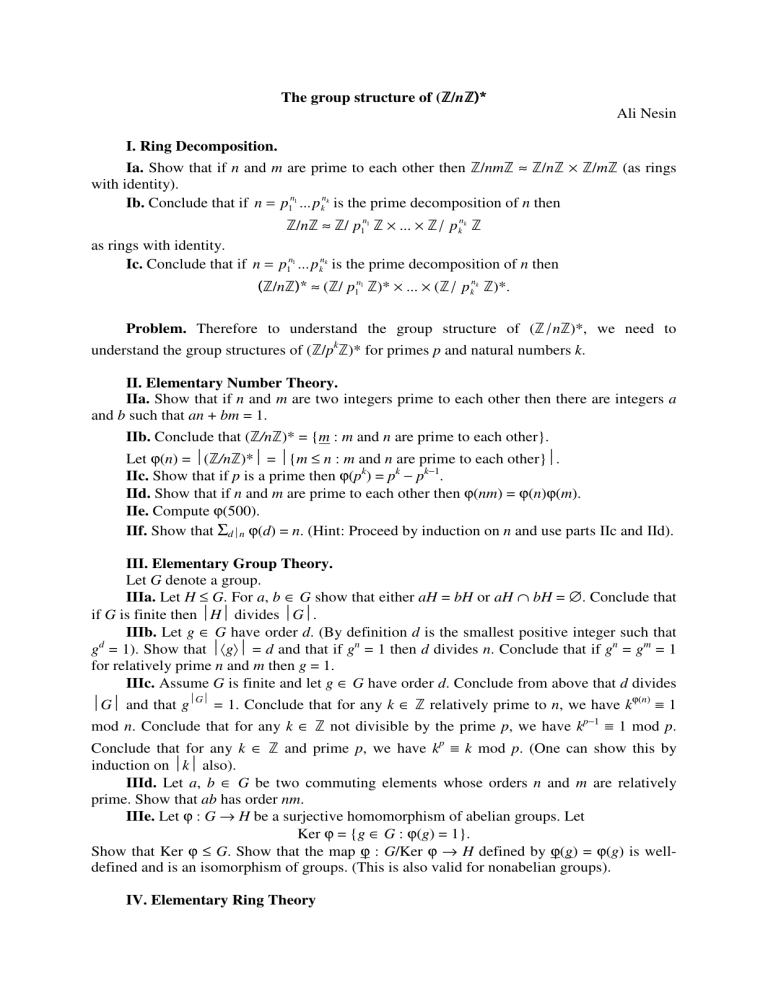
The group structure of ( / n )*
Ali Nesin
I. Ring Decomposition.
Ia.
Show that if n and m are prime to each other then / nm
≈
/ n
×
/ m (as rings with identity).
Ib.
Conclude that if n
= p
1 n
1 ...
p n k k is the prime decomposition of
/ n
≈
/ p
1 n
1
×
...
×
/ n p k k n then as rings with identity.
Ic.
Conclude that if n
= p
1 n
1 ...
p n k k is the prime decomposition of
( / n )*
≈
( / p
1 n
1 )*
×
...
×
( / n p )*. k k n then
Problem. Therefore to understand the group structure of ( / n )*, we need to understand the group structures of ( / p k
)* for primes p and natural numbers k .
II. Elementary Number Theory.
IIa.
Show that if n and m are two integers prime to each other then there are integers a and b such that an + bm = 1.
IIb. Conclude that ( /n )* = { m : m and n are prime to each other}.
Let ϕ
( n ) =
( /n )*
=
{ m
≤ n : m and n are prime to each other}
.
IIc.
Show that if p is a prime then ϕ
( p k
) = p k − p k
−
1
.
IId. Show that if n and m are prime to each other then ϕ
( nm ) = ϕ
( n ) ϕ
( m ).
IIe.
Compute ϕ
(500).
IIf.
Show that
Σ
d
n ϕ
( d ) = n . (Hint: Proceed by induction on n and use parts IIc and IId).
III.
Elementary Group Theory. g d
Let G denote a group.
IIIa.
Let H
≤
G . For a , b
∈
G show that either aH = bH or aH
∩ bH =
∅
. Conclude that if G is finite then
H
divides
G
.
IIIb.
Let g
∈
G have order d . (By definition d is the smallest positive integer such that
= 1). Show that
⟨ g ⟩
= d and that if g n
= 1 then d divides n . Conclude that if g n
= g m
= 1 for relatively prime n and m then g = 1.
IIIc.
Assume G is finite and let g
∈
G have order d . Conclude from above that d divides
G
and that g
G
= 1. Conclude that for any k
∈
relatively prime to n , we have k ϕ
( n ) ≡
1 mod n . Conclude that for any k
∈
not divisible by the prime p , we have k p
−
1 ≡
1 mod p .
Conclude that for any k
∈
and prime p , we have k p ≡ k mod p . (One can show this by induction on
k
also).
IIId.
Let a , b
∈
G be two commuting elements whose orders n and m are relatively prime. Show that ab has order nm .
IIIe.
Let ϕ
: G
→
H be a surjective homomorphism of abelian groups. Let
Ker ϕ
= { g
∈
G : ϕ
( g ) = 1}.
Show that Ker ϕ ≤
G . Show that the map ϕ
: G /Ker ϕ →
H defined by ϕ
( g ) = ϕ
( g ) is welldefined and is an isomorphism of groups. (This is also valid for nonabelian groups).
IV.
Elementary Ring Theory
Let R be a ring and f ( X )
∈
R [ X ].
IVa.
Show that if r
∈
R is a root of f then X
− r divides f .
IVb.
Show that if R is a domain and r
1
, ..., r k
∈
R are distinct roots of f then
( X
− r
1
)( X
− r
2
) ... ( X
− r k
) divides f .
IVc. Conclude that a polynomial f over a domain can have at most deg f distinct roots in the domain. Conclude that the polynomial X d −
1 has at most d roots in a field.
IVd.
Find a counterexample to IVb and IVc if R is not a domain.
V. Case k = 1.
Va.
Show that / n is a field if and only if n is a prime.
From now on we let K denote a field and G , a finite multiplicative subgroup of K *. We will show that G is cyclic. By setting K = / p , this will show that ( / p )*
≈
/( p
−
1) , settling the case k = 1.
Let
G
= n . It is enough to show that G has an element of order n .
Vb.
Let g
∈
G have order d . Show that { x
∈
G : x d
= 1} = ⟨ g ⟩
≈
/ d . (Hint: Everything takes place in a field!)
Vc.
Let d be a divisor of n . Conclude from above that G has either 0 or ϕ
( d ) elements of order d .
Vd.
Using IIf and Vc show that G has (exactly ϕ
( n )) elements of order n .
Ve.
Conclude that G is cyclic. Conclude that ( / p )*
≈
/( p
−
1) .
VI. Case p > 2 and k > 1. p k
−
1
We let R = / p k and since p k
−
1
and
and p
−
1 of R *. We will show that 1 + p is an element of R * of order p k difficult to find explicitly an element of order p
−
1.
VIa.
Show that any a
∈
R can be written as for some unique a
0 p
−
. We will show that
R a
*
=
= a
0 p k
+ a
R
−
1
* is cyclic. Since p k
−
1
= p k
−
1
( p
−
1)
1 are prime to each other, by IIId, it is enough to find elements of order p + ... + a k
−
1 p k
−
1
, ..., a k
−
1
∈
{0, 1, ..., p
−
1}. From now on, given a
∈
R , a
−
1
. It is more
0
will denote the above “first coordinate” of a .
VIb.
Show that a
∈
R * iff a
VIc.
Show that for all i , 1 +
0
≠
0. p i
R
≤
R *.
VId.
Show that
1 + pR
= p k
−
1
and that
R */(1+ pR )
= p
−
1.
VIe. Show that if p > 2 and a
∈
1 + p i
R * then a p ∈
1 + p i +1
R *. Show that this is false if p
= 2. Conclude that the order of 1 + p is p k
−
1
.
Now we will find an element of order p
−
1.
VIf.
Let ϕ
: R *
→
R * be the group homomorphism defined by ϕ
( r ) = r p
−
1
. Show that ϕ
( R *)
≤
1 + pR . (Hint: IIIc.)
VIg.
Show that ϕ
restricted to 1 + pR is one-to-one. (Hint: VId). Conclude that ϕ
( R *) =
1 + pR .
VIi.
Conclude that R *
≈
(1 + pR )
×
{ r
∈
R * : r p
−
1
= 1}. (Hint : VIg, IIIe, IIIb).
VIj.
Let
ψ
: R *
→
( / p )* be defined by
ψ
( a ) = [ a
0
]. Show that
ψ
is a surjective homomorphism of groups. Conclude that R */(1+ pR )
≈
( / p )*
≈
/( p
−
1) . (Hint IIIe).
VIk.
Conclude from VIi and VIj that { r
∈
R * : r p
−
1
= 1}
≈
/( p
−
1) . Conclude that R * has an element of order p
−
1. Conclude that R * is cyclic.
VII. Case p = 2 and k > 1.
Show that ( /2 k
)*
≈
/2 k
−
2 ×
VIII.
General Teorem.
Conclude from all the above that
/2 . (Details will be given later).
1) if 4 does not divide n , ( / n )*
≈
/ ϕ
( n ) ,
2) if 4 divides n , ( / n )*
≈
/ ϕ
( n /2)
×
/2 .

